Central Queensland University: Building Law and Regulation Assignment
VerifiedAdded on 2022/08/28
|11
|2949
|36
Homework Assignment
AI Summary
This assignment delves into the intricacies of building law and regulation, addressing key legal principles within the construction industry. It examines a scenario involving a breach of contract, where a builder fails to complete renovations within the stipulated timeframe, and explores the legal implications, including consequential losses and deceptive conduct. The assignment discusses the concept of mediation as an alternative dispute resolution method, outlining the roles of NSW Fair Trading and NCAT in resolving building disputes. Furthermore, it elucidates the concept of 'duty of care' in building construction, emphasizing contractual obligations and the potential for negligence. The assignment also explores the application of 'res ipsa loquitur' in proving negligence and provides insights into relevant legal precedents. The student has provided a detailed analysis of breach of contract, mediation, and duty of care, providing valuable insights into the legal aspects of building law.
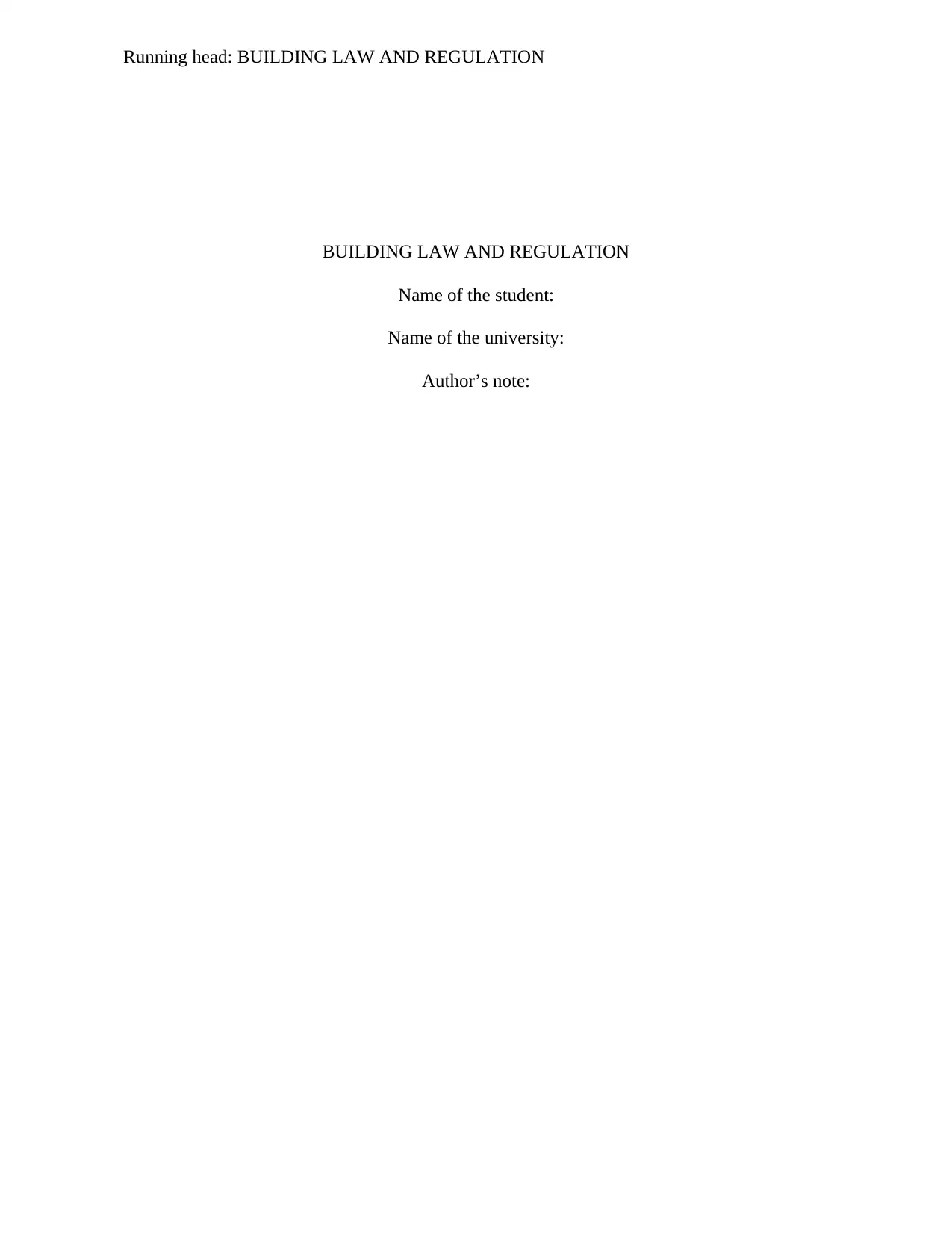
Running head: BUILDING LAW AND REGULATION
0
BUILDING LAW AND REGULATION
Name of the student:
Name of the university:
Author’s note:
0
BUILDING LAW AND REGULATION
Name of the student:
Name of the university:
Author’s note:
Paraphrase This Document
Need a fresh take? Get an instant paraphrase of this document with our AI Paraphraser
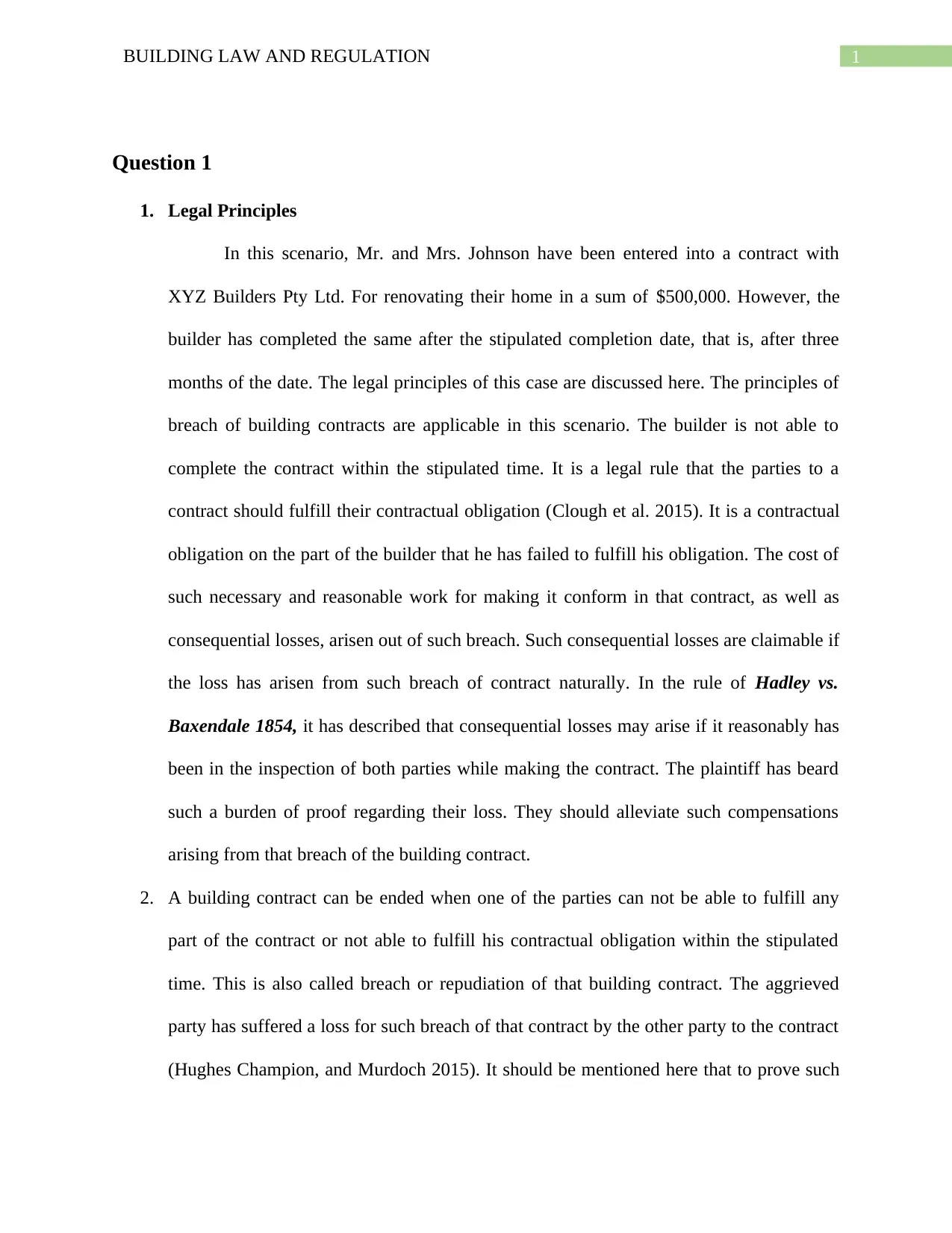
1BUILDING LAW AND REGULATION
Question 1
1. Legal Principles
In this scenario, Mr. and Mrs. Johnson have been entered into a contract with
XYZ Builders Pty Ltd. For renovating their home in a sum of $500,000. However, the
builder has completed the same after the stipulated completion date, that is, after three
months of the date. The legal principles of this case are discussed here. The principles of
breach of building contracts are applicable in this scenario. The builder is not able to
complete the contract within the stipulated time. It is a legal rule that the parties to a
contract should fulfill their contractual obligation (Clough et al. 2015). It is a contractual
obligation on the part of the builder that he has failed to fulfill his obligation. The cost of
such necessary and reasonable work for making it conform in that contract, as well as
consequential losses, arisen out of such breach. Such consequential losses are claimable if
the loss has arisen from such breach of contract naturally. In the rule of Hadley vs.
Baxendale 1854, it has described that consequential losses may arise if it reasonably has
been in the inspection of both parties while making the contract. The plaintiff has beard
such a burden of proof regarding their loss. They should alleviate such compensations
arising from that breach of the building contract.
2. A building contract can be ended when one of the parties can not be able to fulfill any
part of the contract or not able to fulfill his contractual obligation within the stipulated
time. This is also called breach or repudiation of that building contract. The aggrieved
party has suffered a loss for such breach of that contract by the other party to the contract
(Hughes Champion, and Murdoch 2015). It should be mentioned here that to prove such
Question 1
1. Legal Principles
In this scenario, Mr. and Mrs. Johnson have been entered into a contract with
XYZ Builders Pty Ltd. For renovating their home in a sum of $500,000. However, the
builder has completed the same after the stipulated completion date, that is, after three
months of the date. The legal principles of this case are discussed here. The principles of
breach of building contracts are applicable in this scenario. The builder is not able to
complete the contract within the stipulated time. It is a legal rule that the parties to a
contract should fulfill their contractual obligation (Clough et al. 2015). It is a contractual
obligation on the part of the builder that he has failed to fulfill his obligation. The cost of
such necessary and reasonable work for making it conform in that contract, as well as
consequential losses, arisen out of such breach. Such consequential losses are claimable if
the loss has arisen from such breach of contract naturally. In the rule of Hadley vs.
Baxendale 1854, it has described that consequential losses may arise if it reasonably has
been in the inspection of both parties while making the contract. The plaintiff has beard
such a burden of proof regarding their loss. They should alleviate such compensations
arising from that breach of the building contract.
2. A building contract can be ended when one of the parties can not be able to fulfill any
part of the contract or not able to fulfill his contractual obligation within the stipulated
time. This is also called breach or repudiation of that building contract. The aggrieved
party has suffered a loss for such breach of that contract by the other party to the contract
(Hughes Champion, and Murdoch 2015). It should be mentioned here that to prove such
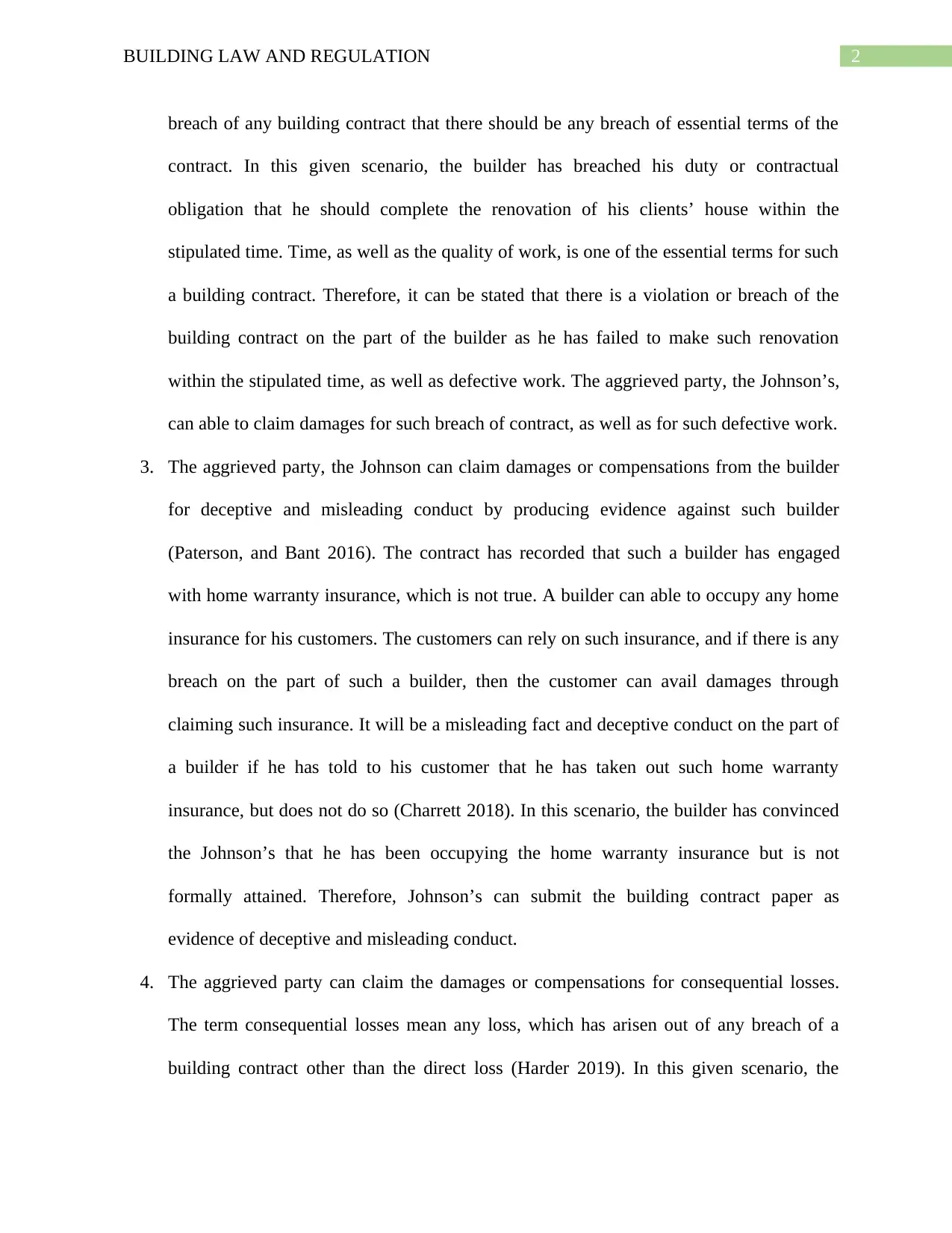
2BUILDING LAW AND REGULATION
breach of any building contract that there should be any breach of essential terms of the
contract. In this given scenario, the builder has breached his duty or contractual
obligation that he should complete the renovation of his clients’ house within the
stipulated time. Time, as well as the quality of work, is one of the essential terms for such
a building contract. Therefore, it can be stated that there is a violation or breach of the
building contract on the part of the builder as he has failed to make such renovation
within the stipulated time, as well as defective work. The aggrieved party, the Johnson’s,
can able to claim damages for such breach of contract, as well as for such defective work.
3. The aggrieved party, the Johnson can claim damages or compensations from the builder
for deceptive and misleading conduct by producing evidence against such builder
(Paterson, and Bant 2016). The contract has recorded that such a builder has engaged
with home warranty insurance, which is not true. A builder can able to occupy any home
insurance for his customers. The customers can rely on such insurance, and if there is any
breach on the part of such a builder, then the customer can avail damages through
claiming such insurance. It will be a misleading fact and deceptive conduct on the part of
a builder if he has told to his customer that he has taken out such home warranty
insurance, but does not do so (Charrett 2018). In this scenario, the builder has convinced
the Johnson’s that he has been occupying the home warranty insurance but is not
formally attained. Therefore, Johnson’s can submit the building contract paper as
evidence of deceptive and misleading conduct.
4. The aggrieved party can claim the damages or compensations for consequential losses.
The term consequential losses mean any loss, which has arisen out of any breach of a
building contract other than the direct loss (Harder 2019). In this given scenario, the
breach of any building contract that there should be any breach of essential terms of the
contract. In this given scenario, the builder has breached his duty or contractual
obligation that he should complete the renovation of his clients’ house within the
stipulated time. Time, as well as the quality of work, is one of the essential terms for such
a building contract. Therefore, it can be stated that there is a violation or breach of the
building contract on the part of the builder as he has failed to make such renovation
within the stipulated time, as well as defective work. The aggrieved party, the Johnson’s,
can able to claim damages for such breach of contract, as well as for such defective work.
3. The aggrieved party, the Johnson can claim damages or compensations from the builder
for deceptive and misleading conduct by producing evidence against such builder
(Paterson, and Bant 2016). The contract has recorded that such a builder has engaged
with home warranty insurance, which is not true. A builder can able to occupy any home
insurance for his customers. The customers can rely on such insurance, and if there is any
breach on the part of such a builder, then the customer can avail damages through
claiming such insurance. It will be a misleading fact and deceptive conduct on the part of
a builder if he has told to his customer that he has taken out such home warranty
insurance, but does not do so (Charrett 2018). In this scenario, the builder has convinced
the Johnson’s that he has been occupying the home warranty insurance but is not
formally attained. Therefore, Johnson’s can submit the building contract paper as
evidence of deceptive and misleading conduct.
4. The aggrieved party can claim the damages or compensations for consequential losses.
The term consequential losses mean any loss, which has arisen out of any breach of a
building contract other than the direct loss (Harder 2019). In this given scenario, the
⊘ This is a preview!⊘
Do you want full access?
Subscribe today to unlock all pages.

Trusted by 1+ million students worldwide
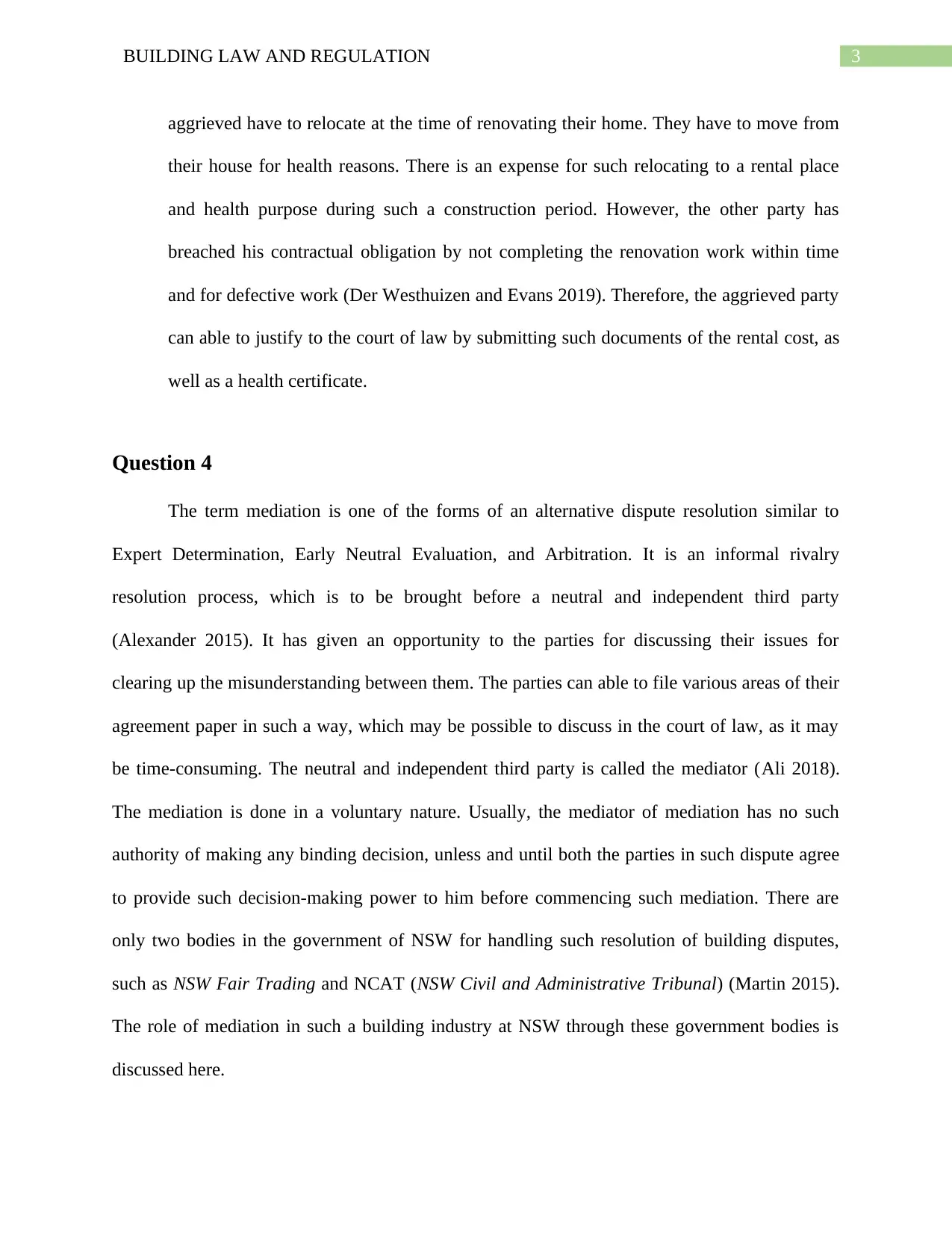
3BUILDING LAW AND REGULATION
aggrieved have to relocate at the time of renovating their home. They have to move from
their house for health reasons. There is an expense for such relocating to a rental place
and health purpose during such a construction period. However, the other party has
breached his contractual obligation by not completing the renovation work within time
and for defective work (Der Westhuizen and Evans 2019). Therefore, the aggrieved party
can able to justify to the court of law by submitting such documents of the rental cost, as
well as a health certificate.
Question 4
The term mediation is one of the forms of an alternative dispute resolution similar to
Expert Determination, Early Neutral Evaluation, and Arbitration. It is an informal rivalry
resolution process, which is to be brought before a neutral and independent third party
(Alexander 2015). It has given an opportunity to the parties for discussing their issues for
clearing up the misunderstanding between them. The parties can able to file various areas of their
agreement paper in such a way, which may be possible to discuss in the court of law, as it may
be time-consuming. The neutral and independent third party is called the mediator (Ali 2018).
The mediation is done in a voluntary nature. Usually, the mediator of mediation has no such
authority of making any binding decision, unless and until both the parties in such dispute agree
to provide such decision-making power to him before commencing such mediation. There are
only two bodies in the government of NSW for handling such resolution of building disputes,
such as NSW Fair Trading and NCAT (NSW Civil and Administrative Tribunal) (Martin 2015).
The role of mediation in such a building industry at NSW through these government bodies is
discussed here.
aggrieved have to relocate at the time of renovating their home. They have to move from
their house for health reasons. There is an expense for such relocating to a rental place
and health purpose during such a construction period. However, the other party has
breached his contractual obligation by not completing the renovation work within time
and for defective work (Der Westhuizen and Evans 2019). Therefore, the aggrieved party
can able to justify to the court of law by submitting such documents of the rental cost, as
well as a health certificate.
Question 4
The term mediation is one of the forms of an alternative dispute resolution similar to
Expert Determination, Early Neutral Evaluation, and Arbitration. It is an informal rivalry
resolution process, which is to be brought before a neutral and independent third party
(Alexander 2015). It has given an opportunity to the parties for discussing their issues for
clearing up the misunderstanding between them. The parties can able to file various areas of their
agreement paper in such a way, which may be possible to discuss in the court of law, as it may
be time-consuming. The neutral and independent third party is called the mediator (Ali 2018).
The mediation is done in a voluntary nature. Usually, the mediator of mediation has no such
authority of making any binding decision, unless and until both the parties in such dispute agree
to provide such decision-making power to him before commencing such mediation. There are
only two bodies in the government of NSW for handling such resolution of building disputes,
such as NSW Fair Trading and NCAT (NSW Civil and Administrative Tribunal) (Martin 2015).
The role of mediation in such a building industry at NSW through these government bodies is
discussed here.
Paraphrase This Document
Need a fresh take? Get an instant paraphrase of this document with our AI Paraphraser
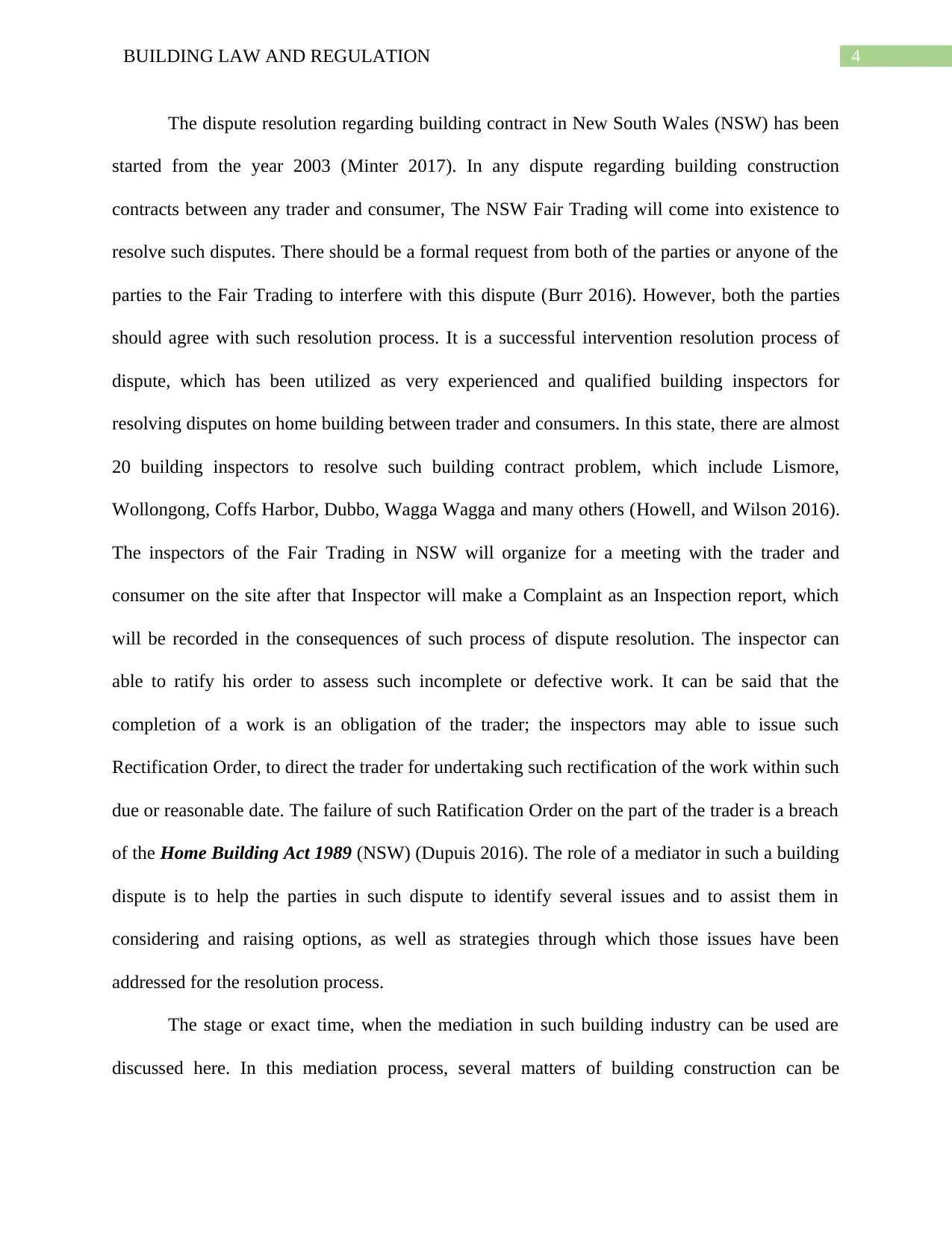
4BUILDING LAW AND REGULATION
The dispute resolution regarding building contract in New South Wales (NSW) has been
started from the year 2003 (Minter 2017). In any dispute regarding building construction
contracts between any trader and consumer, The NSW Fair Trading will come into existence to
resolve such disputes. There should be a formal request from both of the parties or anyone of the
parties to the Fair Trading to interfere with this dispute (Burr 2016). However, both the parties
should agree with such resolution process. It is a successful intervention resolution process of
dispute, which has been utilized as very experienced and qualified building inspectors for
resolving disputes on home building between trader and consumers. In this state, there are almost
20 building inspectors to resolve such building contract problem, which include Lismore,
Wollongong, Coffs Harbor, Dubbo, Wagga Wagga and many others (Howell, and Wilson 2016).
The inspectors of the Fair Trading in NSW will organize for a meeting with the trader and
consumer on the site after that Inspector will make a Complaint as an Inspection report, which
will be recorded in the consequences of such process of dispute resolution. The inspector can
able to ratify his order to assess such incomplete or defective work. It can be said that the
completion of a work is an obligation of the trader; the inspectors may able to issue such
Rectification Order, to direct the trader for undertaking such rectification of the work within such
due or reasonable date. The failure of such Ratification Order on the part of the trader is a breach
of the Home Building Act 1989 (NSW) (Dupuis 2016). The role of a mediator in such a building
dispute is to help the parties in such dispute to identify several issues and to assist them in
considering and raising options, as well as strategies through which those issues have been
addressed for the resolution process.
The stage or exact time, when the mediation in such building industry can be used are
discussed here. In this mediation process, several matters of building construction can be
The dispute resolution regarding building contract in New South Wales (NSW) has been
started from the year 2003 (Minter 2017). In any dispute regarding building construction
contracts between any trader and consumer, The NSW Fair Trading will come into existence to
resolve such disputes. There should be a formal request from both of the parties or anyone of the
parties to the Fair Trading to interfere with this dispute (Burr 2016). However, both the parties
should agree with such resolution process. It is a successful intervention resolution process of
dispute, which has been utilized as very experienced and qualified building inspectors for
resolving disputes on home building between trader and consumers. In this state, there are almost
20 building inspectors to resolve such building contract problem, which include Lismore,
Wollongong, Coffs Harbor, Dubbo, Wagga Wagga and many others (Howell, and Wilson 2016).
The inspectors of the Fair Trading in NSW will organize for a meeting with the trader and
consumer on the site after that Inspector will make a Complaint as an Inspection report, which
will be recorded in the consequences of such process of dispute resolution. The inspector can
able to ratify his order to assess such incomplete or defective work. It can be said that the
completion of a work is an obligation of the trader; the inspectors may able to issue such
Rectification Order, to direct the trader for undertaking such rectification of the work within such
due or reasonable date. The failure of such Ratification Order on the part of the trader is a breach
of the Home Building Act 1989 (NSW) (Dupuis 2016). The role of a mediator in such a building
dispute is to help the parties in such dispute to identify several issues and to assist them in
considering and raising options, as well as strategies through which those issues have been
addressed for the resolution process.
The stage or exact time, when the mediation in such building industry can be used are
discussed here. In this mediation process, several matters of building construction can be
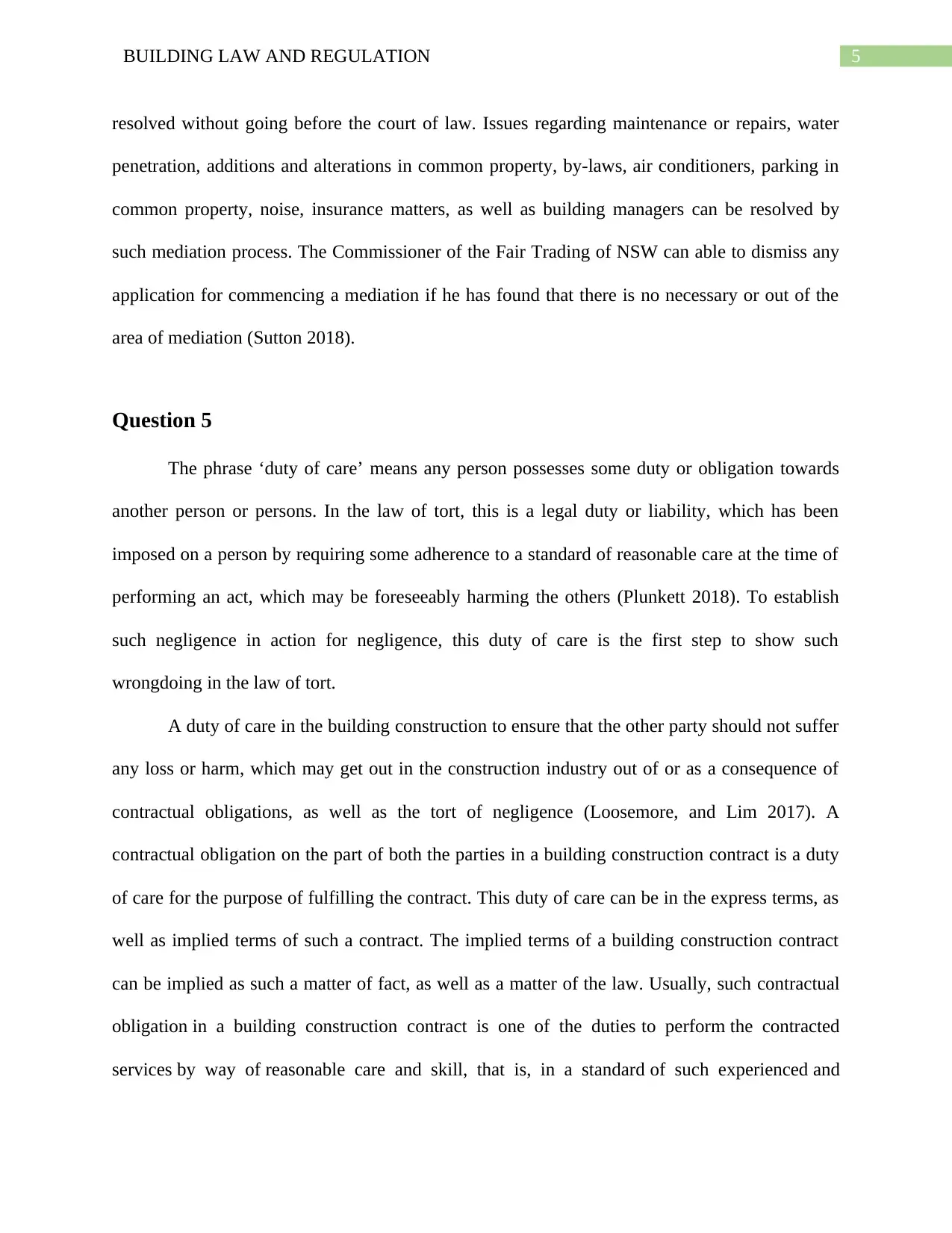
5BUILDING LAW AND REGULATION
resolved without going before the court of law. Issues regarding maintenance or repairs, water
penetration, additions and alterations in common property, by-laws, air conditioners, parking in
common property, noise, insurance matters, as well as building managers can be resolved by
such mediation process. The Commissioner of the Fair Trading of NSW can able to dismiss any
application for commencing a mediation if he has found that there is no necessary or out of the
area of mediation (Sutton 2018).
Question 5
The phrase ‘duty of care’ means any person possesses some duty or obligation towards
another person or persons. In the law of tort, this is a legal duty or liability, which has been
imposed on a person by requiring some adherence to a standard of reasonable care at the time of
performing an act, which may be foreseeably harming the others (Plunkett 2018). To establish
such negligence in action for negligence, this duty of care is the first step to show such
wrongdoing in the law of tort.
A duty of care in the building construction to ensure that the other party should not suffer
any loss or harm, which may get out in the construction industry out of or as a consequence of
contractual obligations, as well as the tort of negligence (Loosemore, and Lim 2017). A
contractual obligation on the part of both the parties in a building construction contract is a duty
of care for the purpose of fulfilling the contract. This duty of care can be in the express terms, as
well as implied terms of such a contract. The implied terms of a building construction contract
can be implied as such a matter of fact, as well as a matter of the law. Usually, such contractual
obligation in a building construction contract is one of the duties to perform the contracted
services by way of reasonable care and skill, that is, in a standard of such experienced and
resolved without going before the court of law. Issues regarding maintenance or repairs, water
penetration, additions and alterations in common property, by-laws, air conditioners, parking in
common property, noise, insurance matters, as well as building managers can be resolved by
such mediation process. The Commissioner of the Fair Trading of NSW can able to dismiss any
application for commencing a mediation if he has found that there is no necessary or out of the
area of mediation (Sutton 2018).
Question 5
The phrase ‘duty of care’ means any person possesses some duty or obligation towards
another person or persons. In the law of tort, this is a legal duty or liability, which has been
imposed on a person by requiring some adherence to a standard of reasonable care at the time of
performing an act, which may be foreseeably harming the others (Plunkett 2018). To establish
such negligence in action for negligence, this duty of care is the first step to show such
wrongdoing in the law of tort.
A duty of care in the building construction to ensure that the other party should not suffer
any loss or harm, which may get out in the construction industry out of or as a consequence of
contractual obligations, as well as the tort of negligence (Loosemore, and Lim 2017). A
contractual obligation on the part of both the parties in a building construction contract is a duty
of care for the purpose of fulfilling the contract. This duty of care can be in the express terms, as
well as implied terms of such a contract. The implied terms of a building construction contract
can be implied as such a matter of fact, as well as a matter of the law. Usually, such contractual
obligation in a building construction contract is one of the duties to perform the contracted
services by way of reasonable care and skill, that is, in a standard of such experienced and
⊘ This is a preview!⊘
Do you want full access?
Subscribe today to unlock all pages.

Trusted by 1+ million students worldwide
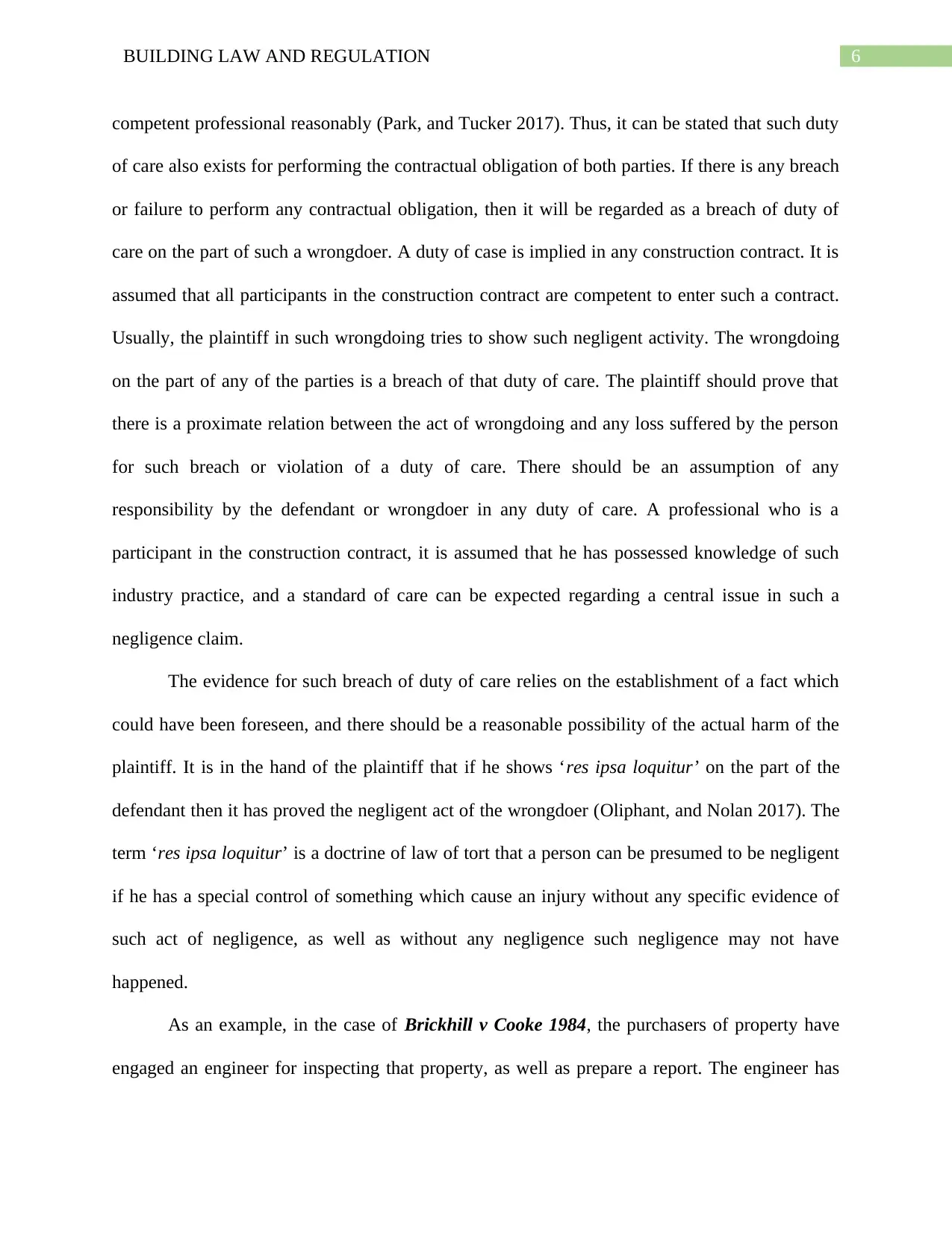
6BUILDING LAW AND REGULATION
competent professional reasonably (Park, and Tucker 2017). Thus, it can be stated that such duty
of care also exists for performing the contractual obligation of both parties. If there is any breach
or failure to perform any contractual obligation, then it will be regarded as a breach of duty of
care on the part of such a wrongdoer. A duty of case is implied in any construction contract. It is
assumed that all participants in the construction contract are competent to enter such a contract.
Usually, the plaintiff in such wrongdoing tries to show such negligent activity. The wrongdoing
on the part of any of the parties is a breach of that duty of care. The plaintiff should prove that
there is a proximate relation between the act of wrongdoing and any loss suffered by the person
for such breach or violation of a duty of care. There should be an assumption of any
responsibility by the defendant or wrongdoer in any duty of care. A professional who is a
participant in the construction contract, it is assumed that he has possessed knowledge of such
industry practice, and a standard of care can be expected regarding a central issue in such a
negligence claim.
The evidence for such breach of duty of care relies on the establishment of a fact which
could have been foreseen, and there should be a reasonable possibility of the actual harm of the
plaintiff. It is in the hand of the plaintiff that if he shows ‘res ipsa loquitur’ on the part of the
defendant then it has proved the negligent act of the wrongdoer (Oliphant, and Nolan 2017). The
term ‘res ipsa loquitur’ is a doctrine of law of tort that a person can be presumed to be negligent
if he has a special control of something which cause an injury without any specific evidence of
such act of negligence, as well as without any negligence such negligence may not have
happened.
As an example, in the case of Brickhill v Cooke 1984, the purchasers of property have
engaged an engineer for inspecting that property, as well as prepare a report. The engineer has
competent professional reasonably (Park, and Tucker 2017). Thus, it can be stated that such duty
of care also exists for performing the contractual obligation of both parties. If there is any breach
or failure to perform any contractual obligation, then it will be regarded as a breach of duty of
care on the part of such a wrongdoer. A duty of case is implied in any construction contract. It is
assumed that all participants in the construction contract are competent to enter such a contract.
Usually, the plaintiff in such wrongdoing tries to show such negligent activity. The wrongdoing
on the part of any of the parties is a breach of that duty of care. The plaintiff should prove that
there is a proximate relation between the act of wrongdoing and any loss suffered by the person
for such breach or violation of a duty of care. There should be an assumption of any
responsibility by the defendant or wrongdoer in any duty of care. A professional who is a
participant in the construction contract, it is assumed that he has possessed knowledge of such
industry practice, and a standard of care can be expected regarding a central issue in such a
negligence claim.
The evidence for such breach of duty of care relies on the establishment of a fact which
could have been foreseen, and there should be a reasonable possibility of the actual harm of the
plaintiff. It is in the hand of the plaintiff that if he shows ‘res ipsa loquitur’ on the part of the
defendant then it has proved the negligent act of the wrongdoer (Oliphant, and Nolan 2017). The
term ‘res ipsa loquitur’ is a doctrine of law of tort that a person can be presumed to be negligent
if he has a special control of something which cause an injury without any specific evidence of
such act of negligence, as well as without any negligence such negligence may not have
happened.
As an example, in the case of Brickhill v Cooke 1984, the purchasers of property have
engaged an engineer for inspecting that property, as well as prepare a report. The engineer has
Paraphrase This Document
Need a fresh take? Get an instant paraphrase of this document with our AI Paraphraser
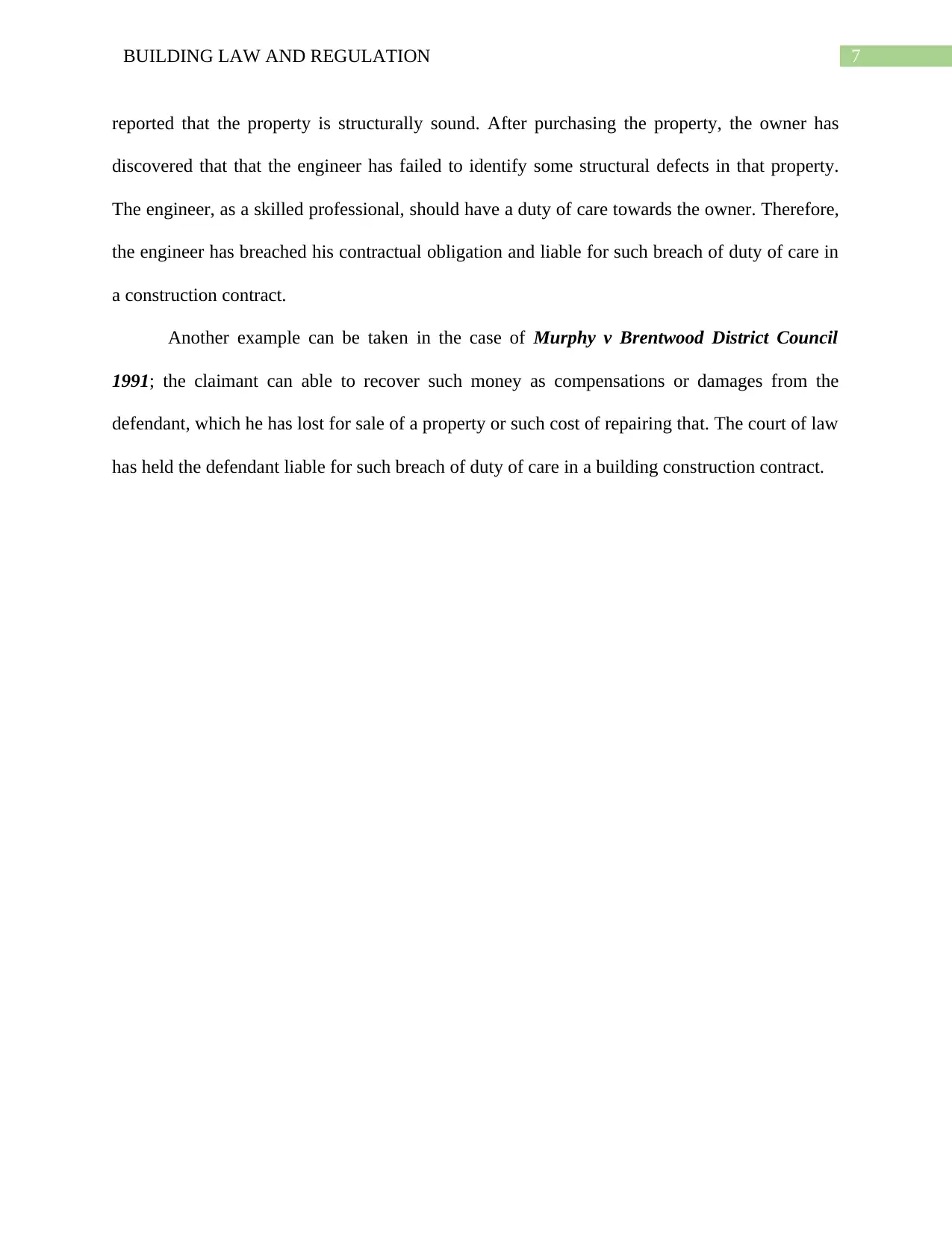
7BUILDING LAW AND REGULATION
reported that the property is structurally sound. After purchasing the property, the owner has
discovered that that the engineer has failed to identify some structural defects in that property.
The engineer, as a skilled professional, should have a duty of care towards the owner. Therefore,
the engineer has breached his contractual obligation and liable for such breach of duty of care in
a construction contract.
Another example can be taken in the case of Murphy v Brentwood District Council
1991; the claimant can able to recover such money as compensations or damages from the
defendant, which he has lost for sale of a property or such cost of repairing that. The court of law
has held the defendant liable for such breach of duty of care in a building construction contract.
reported that the property is structurally sound. After purchasing the property, the owner has
discovered that that the engineer has failed to identify some structural defects in that property.
The engineer, as a skilled professional, should have a duty of care towards the owner. Therefore,
the engineer has breached his contractual obligation and liable for such breach of duty of care in
a construction contract.
Another example can be taken in the case of Murphy v Brentwood District Council
1991; the claimant can able to recover such money as compensations or damages from the
defendant, which he has lost for sale of a property or such cost of repairing that. The court of law
has held the defendant liable for such breach of duty of care in a building construction contract.
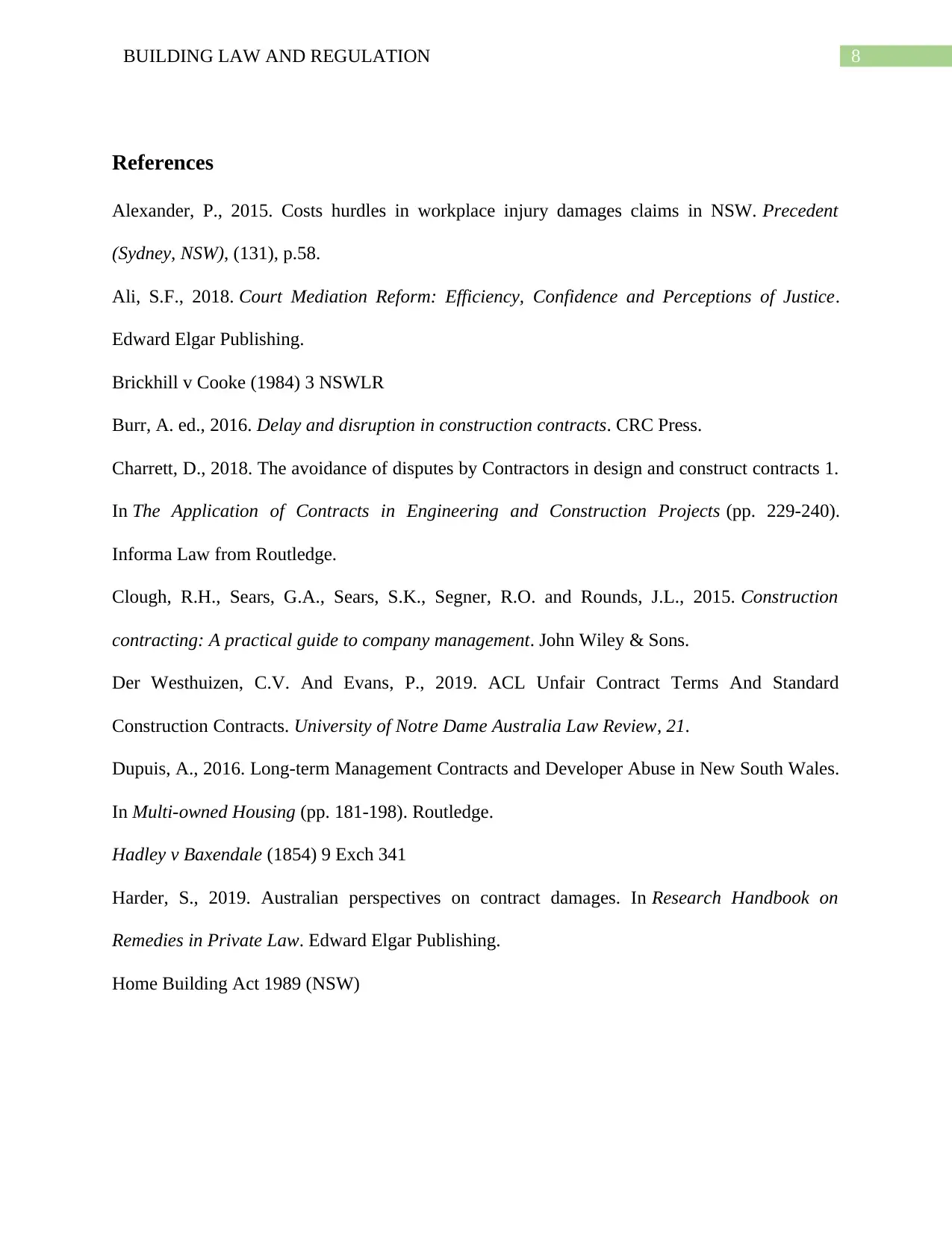
8BUILDING LAW AND REGULATION
References
Alexander, P., 2015. Costs hurdles in workplace injury damages claims in NSW. Precedent
(Sydney, NSW), (131), p.58.
Ali, S.F., 2018. Court Mediation Reform: Efficiency, Confidence and Perceptions of Justice.
Edward Elgar Publishing.
Brickhill v Cooke (1984) 3 NSWLR
Burr, A. ed., 2016. Delay and disruption in construction contracts. CRC Press.
Charrett, D., 2018. The avoidance of disputes by Contractors in design and construct contracts 1.
In The Application of Contracts in Engineering and Construction Projects (pp. 229-240).
Informa Law from Routledge.
Clough, R.H., Sears, G.A., Sears, S.K., Segner, R.O. and Rounds, J.L., 2015. Construction
contracting: A practical guide to company management. John Wiley & Sons.
Der Westhuizen, C.V. And Evans, P., 2019. ACL Unfair Contract Terms And Standard
Construction Contracts. University of Notre Dame Australia Law Review, 21.
Dupuis, A., 2016. Long-term Management Contracts and Developer Abuse in New South Wales.
In Multi-owned Housing (pp. 181-198). Routledge.
Hadley v Baxendale (1854) 9 Exch 341
Harder, S., 2019. Australian perspectives on contract damages. In Research Handbook on
Remedies in Private Law. Edward Elgar Publishing.
Home Building Act 1989 (NSW)
References
Alexander, P., 2015. Costs hurdles in workplace injury damages claims in NSW. Precedent
(Sydney, NSW), (131), p.58.
Ali, S.F., 2018. Court Mediation Reform: Efficiency, Confidence and Perceptions of Justice.
Edward Elgar Publishing.
Brickhill v Cooke (1984) 3 NSWLR
Burr, A. ed., 2016. Delay and disruption in construction contracts. CRC Press.
Charrett, D., 2018. The avoidance of disputes by Contractors in design and construct contracts 1.
In The Application of Contracts in Engineering and Construction Projects (pp. 229-240).
Informa Law from Routledge.
Clough, R.H., Sears, G.A., Sears, S.K., Segner, R.O. and Rounds, J.L., 2015. Construction
contracting: A practical guide to company management. John Wiley & Sons.
Der Westhuizen, C.V. And Evans, P., 2019. ACL Unfair Contract Terms And Standard
Construction Contracts. University of Notre Dame Australia Law Review, 21.
Dupuis, A., 2016. Long-term Management Contracts and Developer Abuse in New South Wales.
In Multi-owned Housing (pp. 181-198). Routledge.
Hadley v Baxendale (1854) 9 Exch 341
Harder, S., 2019. Australian perspectives on contract damages. In Research Handbook on
Remedies in Private Law. Edward Elgar Publishing.
Home Building Act 1989 (NSW)
⊘ This is a preview!⊘
Do you want full access?
Subscribe today to unlock all pages.

Trusted by 1+ million students worldwide
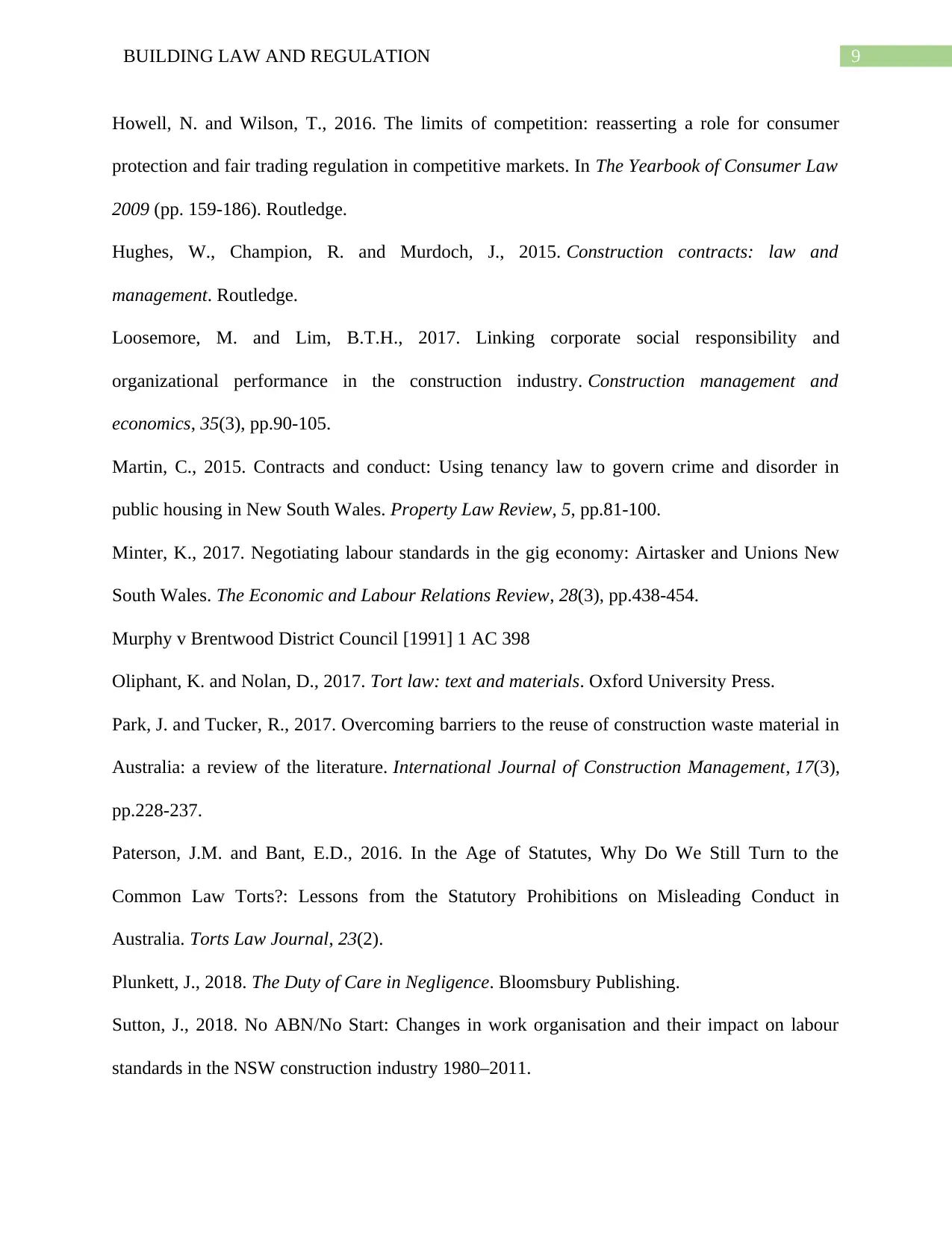
9BUILDING LAW AND REGULATION
Howell, N. and Wilson, T., 2016. The limits of competition: reasserting a role for consumer
protection and fair trading regulation in competitive markets. In The Yearbook of Consumer Law
2009 (pp. 159-186). Routledge.
Hughes, W., Champion, R. and Murdoch, J., 2015. Construction contracts: law and
management. Routledge.
Loosemore, M. and Lim, B.T.H., 2017. Linking corporate social responsibility and
organizational performance in the construction industry. Construction management and
economics, 35(3), pp.90-105.
Martin, C., 2015. Contracts and conduct: Using tenancy law to govern crime and disorder in
public housing in New South Wales. Property Law Review, 5, pp.81-100.
Minter, K., 2017. Negotiating labour standards in the gig economy: Airtasker and Unions New
South Wales. The Economic and Labour Relations Review, 28(3), pp.438-454.
Murphy v Brentwood District Council [1991] 1 AC 398
Oliphant, K. and Nolan, D., 2017. Tort law: text and materials. Oxford University Press.
Park, J. and Tucker, R., 2017. Overcoming barriers to the reuse of construction waste material in
Australia: a review of the literature. International Journal of Construction Management, 17(3),
pp.228-237.
Paterson, J.M. and Bant, E.D., 2016. In the Age of Statutes, Why Do We Still Turn to the
Common Law Torts?: Lessons from the Statutory Prohibitions on Misleading Conduct in
Australia. Torts Law Journal, 23(2).
Plunkett, J., 2018. The Duty of Care in Negligence. Bloomsbury Publishing.
Sutton, J., 2018. No ABN/No Start: Changes in work organisation and their impact on labour
standards in the NSW construction industry 1980–2011.
Howell, N. and Wilson, T., 2016. The limits of competition: reasserting a role for consumer
protection and fair trading regulation in competitive markets. In The Yearbook of Consumer Law
2009 (pp. 159-186). Routledge.
Hughes, W., Champion, R. and Murdoch, J., 2015. Construction contracts: law and
management. Routledge.
Loosemore, M. and Lim, B.T.H., 2017. Linking corporate social responsibility and
organizational performance in the construction industry. Construction management and
economics, 35(3), pp.90-105.
Martin, C., 2015. Contracts and conduct: Using tenancy law to govern crime and disorder in
public housing in New South Wales. Property Law Review, 5, pp.81-100.
Minter, K., 2017. Negotiating labour standards in the gig economy: Airtasker and Unions New
South Wales. The Economic and Labour Relations Review, 28(3), pp.438-454.
Murphy v Brentwood District Council [1991] 1 AC 398
Oliphant, K. and Nolan, D., 2017. Tort law: text and materials. Oxford University Press.
Park, J. and Tucker, R., 2017. Overcoming barriers to the reuse of construction waste material in
Australia: a review of the literature. International Journal of Construction Management, 17(3),
pp.228-237.
Paterson, J.M. and Bant, E.D., 2016. In the Age of Statutes, Why Do We Still Turn to the
Common Law Torts?: Lessons from the Statutory Prohibitions on Misleading Conduct in
Australia. Torts Law Journal, 23(2).
Plunkett, J., 2018. The Duty of Care in Negligence. Bloomsbury Publishing.
Sutton, J., 2018. No ABN/No Start: Changes in work organisation and their impact on labour
standards in the NSW construction industry 1980–2011.
Paraphrase This Document
Need a fresh take? Get an instant paraphrase of this document with our AI Paraphraser
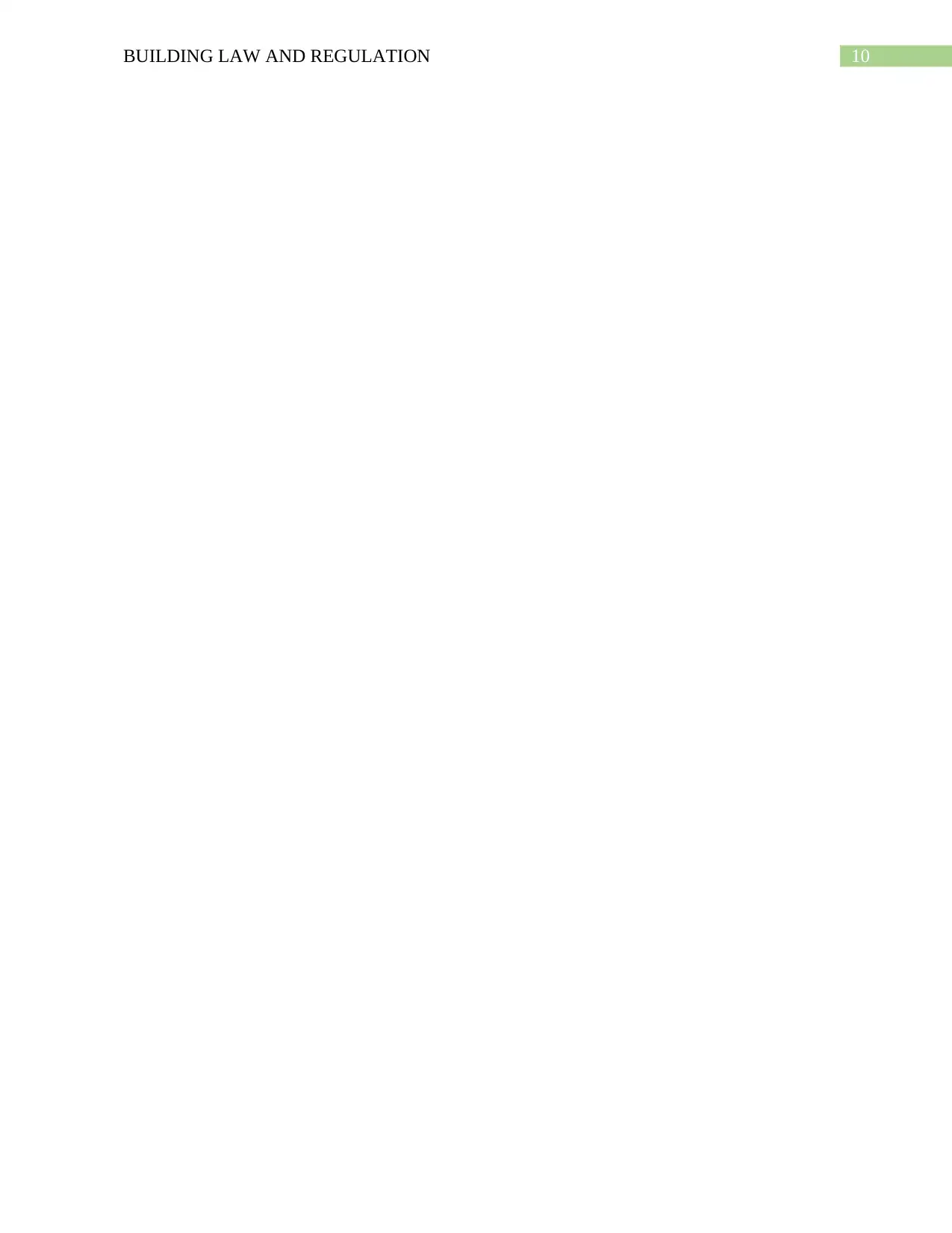
10BUILDING LAW AND REGULATION
1 out of 11
Related Documents
Your All-in-One AI-Powered Toolkit for Academic Success.
+13062052269
info@desklib.com
Available 24*7 on WhatsApp / Email
![[object Object]](/_next/static/media/star-bottom.7253800d.svg)
Unlock your academic potential
Copyright © 2020–2025 A2Z Services. All Rights Reserved. Developed and managed by ZUCOL.





